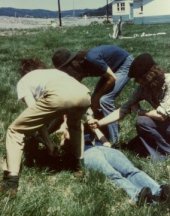The following is a report of the committee's investigation of the "Blockhouse Site" at Placentia, June 5, 1972.
The area called "The Blockhouse", located in the southeast end of Placentia, is so named because there was supposed to have been some sort of French fortifications there. These fortifications offered protection to that side of the harbour from English ships. The committee's intention was to try to locate the foundations of the actual Blockhouse site and thereby prove that such a fortification did exist.
 Locally, practically no historical information concerning the Blockhouse was available.
Consequently, further information relating to the site was sought in the Provincial Archives in St.
Johns. Some information was obtained through interviews with the older residents of Placentia
who informed us of the location of buildings previously situated on the Blockhouse site. and of
folklore connected with the site. There were two interviews; the first with Mrs. Anne Patterson,
Placentia, the second with Mrs. O'Rielly, Blockhouse, Placentia.
Locally, practically no historical information concerning the Blockhouse was available.
Consequently, further information relating to the site was sought in the Provincial Archives in St.
Johns. Some information was obtained through interviews with the older residents of Placentia
who informed us of the location of buildings previously situated on the Blockhouse site. and of
folklore connected with the site. There were two interviews; the first with Mrs. Anne Patterson,
Placentia, the second with Mrs. O'Rielly, Blockhouse, Placentia.
 Field work at the Blockhouse site included four test trenches, one on beach rock, and three on the
grassy meadow which supposedly includes the site. Artifacts uncovered in these trenches were
marked and cataloged.
Field work at the Blockhouse site included four test trenches, one on beach rock, and three on the
grassy meadow which supposedly includes the site. Artifacts uncovered in these trenches were
marked and cataloged.
The committee's investigation proved unsuccessful as far as locating the actual Blockhouse site is concerned. Our research did uncover important historical background on the Blockhouse. The artifacts which were found in our excavation indicate that there was indeed some sort of occupation at the Blockhouse.
Committee's interview with Mrs. Anne Patterson, Placentia, concerning former buildings and residents at the Blockhouse. Interview was conducted by Wayne Carroll and Paul Rowe on June 7, 1972.
When Mrs. Patterson was asked about any buildings that had been located in or near the Blockhouse Cove, she stated that she remembers only one house to the right of Mr. Bill O'Rielly's, which is the first house on the right side of the lane. (Tunis Street) This house was near the waters edge and belonged to a man called Fewer. (The committee was unable to locate this site). On the site where resent houses are, there was once a large house belonging to Jim Patterson. An Englishman called Fitzgibbons, whose name is connected with the history of the Blockhouse, used to stay in this house during the summer months. According to Mrs. Patterson, these were the only buildings in the Blockhouse Cove.
On the left side of the long lane referred to as Tunis Street there were several buildings, one of these being the former Patterson house, which still stands directly opposite the N.L.C. building. Another house, now occupied by the Whittle family, once belonged to Julia Donne. Further in the lane there was a small building belonging to Mike Grace. To the left of this, there stands an old two story house, now unoccupied. A Mrs. Ann Grace once lived in this house. Far to the left of this, near the water, Mrs. Patterson remembers two small buildings owned by Mr. Grace. One building was his house; the other was a stable. Neither of these buildings still stand.
 Committee's interview with Mrs. Bill O'Rielly, resident of the Blockhouse for the past 80 years,
on June 8, 1972. Interview conducted by R. John Phippard and Paul Rowe.
Committee's interview with Mrs. Bill O'Rielly, resident of the Blockhouse for the past 80 years,
on June 8, 1972. Interview conducted by R. John Phippard and Paul Rowe.
In reply to questions concerning the possible location of the Blockhouse site Mr. O'Rielly stated that the area had been given the name because there was once a French fortification located in the Blockhouse Cove. An indication that there was a French occupation there at one time is the French clay pipe which Mrs. O'Rielly found on the Blockhouse area.
Other questions revealed information similar to that obtained from Mrs. Patterson.